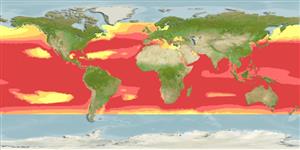Common names from other countries
Environment: milieu / climate zone / depth range / distribution range
Écologie
marin; océanodrome; profondeur 0 - 260 m (Ref. 9340), usually 0 - ? m (Ref. 55287). Tropical; 15°C - 30°C (Ref. 168); 63°N - 47°S, 180°W - 180°E
Cosmopolitan in tropical and warm-temperate waters. Not found in the Black Sea. Highly migratory species,
Length at first maturity / Taille / Poids / Âge
Maturity: Lm 41.3, range 40 - 45 cm
Max length : 110 cm FL mâle / non sexé; (Ref. 89423); common length : 80.0 cm FL mâle / non sexé; (Ref. 168); poids max. publié: 34.5 kg (Ref. 168); âge max. reporté: 12 années (Ref. 168)
Épines dorsales (Total): 14 - 16; Rayons mous dorsaux (Total): 14-15; Épines anales 0; Rayons mous anaux: 14 - 15; Vertèbres: 41. This species is distinguished by the following characters: body fusiform, elongate and rounded; teeth small and conical, in a single series; gill rakers on first gill arch numerous, 53-63; D1 XIV-XVI, dorsal fins separated by a small interspace (not larger than eye), the second followed by 7-9 finlets; anal fin followed by 7-8 finlets; pectoral fins short, with 26-27 rays; 2 flaps (interpelvic process) between pelvic fins; body scaleless except for corselet and lateral line; a strong keel on each side of caudal-fin base between 2 smaller keels. Colour of back dark purplish blue, lower sides and belly silvery, with 4-6 very conspicuous longitudinal dark bands which in live specimens may appear as discontinuous lines of dark blotches (Ref. 9684).
Found in offshore waters; larvae restricted to waters with surface temperatures of 15°C to 30°C (Ref. 6390). Exhibit a strong tendency to school in surface waters with birds, drifting objects, sharks, whales and may show a characteristic behavior like jumping, feeding, foaming, etc. Feed on fishes, crustaceans, cephalopods and mollusks; cannibalism is common. Spawn throughout the year in the tropics, eggs released in several portions (Ref. 35388). Eggs and larvae are pelagic (Ref. 6769). Preyed upon by large pelagic fishes (Ref. 6885). Also taken by trolling on light tackle using plugs, spoons, feathers, or strip bait (Ref. 9684). Marketed fresh, frozen or canned (Ref. 9340, 9684 ); also dried-salted and smoked (Ref. 9987).
In tropical waters, reproductively active female skipjack tuna spawn almost daily.
Collette, B.B. and C.E. Nauen, 1983. FAO Species Catalogue. Vol. 2. Scombrids of the world. An annotated and illustrated catalogue of tunas, mackerels, bonitos and related species known to date. Rome: FAO. FAO Fish. Synop. 125(2):137 p. (Ref. 168)
Statut dans la liste rouge de l'IUCN (Ref. 130435)
Warning: mysqli::__construct(): (HY000/1040): Too many connections in /var/www/html/includes/func_getlabel.php on line 46
Can't connect to MySQL database (fbapp). Errorcode: Too many connections
